The essence of the problem is that I suddenly needed to make a retrospective of the used domestic (well, ok, and foreign too) individual anti-chemical packages (PPI) used to remove toxic substances from skin / clothes. PPIs are a fairly utilitarian thing, it is not surprising that someone can confuse the abbreviation PPI with an individual dressing package, and someone even with sexually transmitted infections. Adds fuel to the fire and two features that I noticed while looking for subject information. The first feature is the secrecy and confusion (deliberate?) Of information, even about the IPP of the Second World War. Many magazine articles have missing pages. I am more than sure that this will not help any protection of secrecy, but it will seriously complicate the task for people who are studying this topic.The second feature is the lack of professionalism of military chemists, or military chemist teachers, who often write their textbooks with flagrant errors.
Therefore, the main purpose of the article is informational, as a "habr-encyclopedist" :) The next time some conventional military chemist cadet (who "protects my peace") looks for information for his abstract, let him stumble upon mine. article (
In general, under the cut is a retrospective of means of individual degassing and a bonus attempt to scale the accumulated knowledge to a completely everyday area - the decontamination of "pepper tear gas".
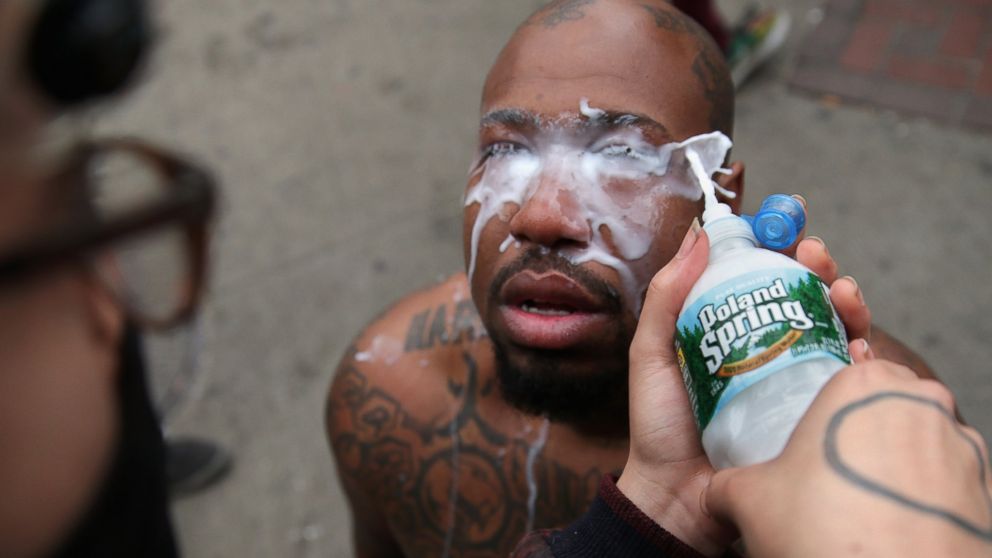
Intro
The first time mustard gas was used in the First World War in the region of the Ypres River, for which it was named mustard gas. It was the first toxic substance (OS), which, in addition to affecting the respiratory tract, also affected the body through the skin. Cases of repeated defeat due to desorption from clothing and weapons have been identified. "How it works" can be roughly seen in the acclaimed film Battalion

It is not surprising that, taught by the bitter experience of the First World War, the troops of almost all countries learned to use chemistry and repel chemical attacks. The first solution to this problem was degassing teams, which were urgently created in the troops, but this did not completely solve this problem in view of the fact that these teams could not immediately start their activities. A logical move was the decision to create a tool that would allow soldiers to independently carry out anti-chemical treatment. This means of individual protection and became anti-chemical bags. The main functionality of most PPIs is the rapid degassing of OM drops on the surface of open skin areas. Calcium hypochlorite (German losanthine, Japanese PPI) or chloramines (Hungarian, Polish PPI, etc.). Outwardly, batch degassers were most often produced in the form of powder (Japanese, Hungarian, Polish IPP, etc.), tablets (German lozantin), liquid (most packages of the Soviet Red Army), or ointment (German IPP 1942, American " anti- gas ointment ", etc.). Sometimes the packages contained, in addition to degassing agents, some auxiliary components like sodium bicarbonate ~ soda (Polish IPP), ampoules with an anti-smoke mixture (TD-2 / TD-5 / IPP-3 packages in the Red Army).
In general, we can say that chemically active substances are most often used for degassing, which quickly enter into chemical interaction with OM and transfer them into a harmless state. Such substances can be divided into two groups:
- - , V- ( , , ).
- : , , , , , . , , ( ) ( ) .
Unlike rather complex formulations, the use of PPIs, as a rule, was as simple as possible and was reduced to careful removal of OM drops from the skin surface (with filter paper, lignin, cotton wool, or some other handy material) and rubbing into the infected area of the degasser, which through it was recommended to wash off this or that period from the skin.
After general information, we turn to private information. To a retrospective of the individual anti-chemical packages of the Soviet Army (and the Russian army).
Domestic API
A tin box with tampons dipped in kerosene, which appeared in the army and navy in 1930, can be considered the ancestor of such a phenomenon as the Soviet IPP.
In 1932-1935 this " IPP-0 " was replaced with a new package TD-2 ( IPP-1 ), where a solution of an organic solvent neutralizer was used as a degasser. Information differs from source to source, while at the site of the train: ________. It is quite possible - bleach or chloramine. The advantage of the TD-2 package was that, in contrast to kerosene, there was no danger of OM smearing on the skin surface, since the toxin quickly disintegrated from contact with the degasser.

In this package there were "bonus" ampoules with anti-smoke mixture (there will be a remark about the mixture below). In the next revision of the IPP - TD-5 ( IPP-2 ), the nitrocellulose boxes with the anti-smoke mixture were replaced with small glass ampoules. The release of IPP-2 lasted until 1938-1939, then this degassing package was replaced by IPP-3.
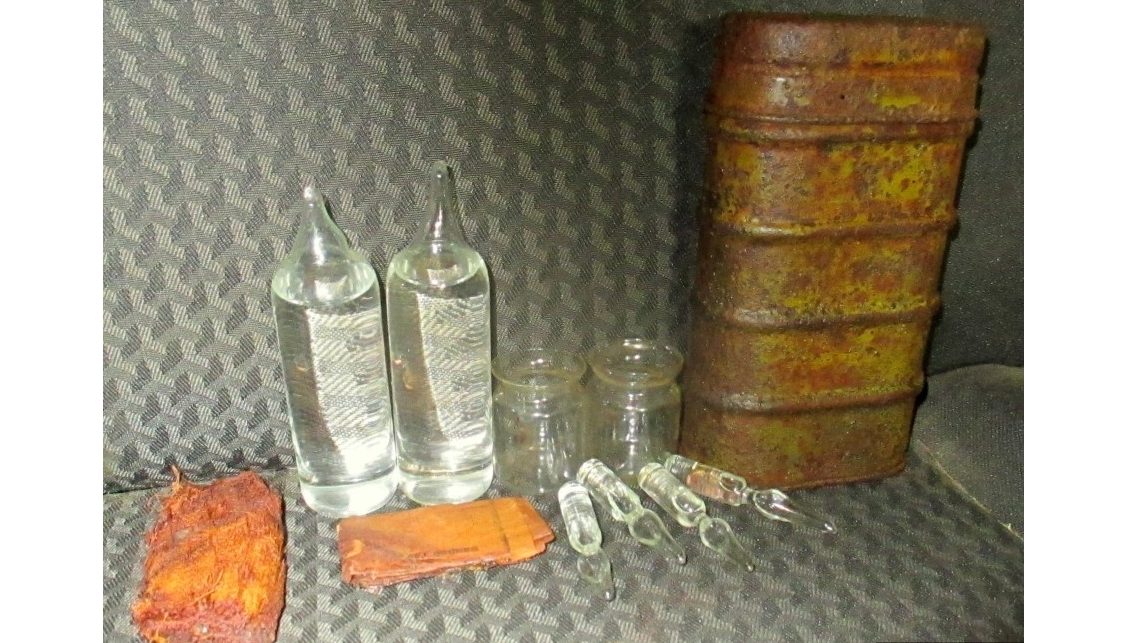
IPP-3was a metal box in which there were 2 large ampoules for neutralizing mustard gas and lusite on the skin, 4 small ampoules with an anti-smoke mixture and gauze napkins. Each large ampoule was placed in a bag with an eyelet, and its sharp end rested against another container, a small figured jar with a wide neck, into which the powder was pressed. When using it, it was suggested to break both glasses without removing the bag and shake 10-15 times to speed up the dissolution of the powder in the liquid. Then, squeezing the ampoule with your hand (do not remove the bag!), Moisten a piece of gauze with liquid and wipe the exposed skin with it. Under the conditions of 1941, this IPP had serious drawbacks: the tin box was expensive to manufacture, and since the large ampoules contained an alcohol-based substance, the soldiers strove to constantly consume it.which led to poisoning.
Therefore, to replace the IPP-3 in 1941. IPP-5 was adopted . It was a bottle in a gauze cover filled with 100 ml of liquid degasser. The bottle was wrapped in rayon or paper. Two gauze napkins are placed above the bottle cap, and the rules of use are on the side surface of the bottle. The weight of the loaded package was about 290 g. In general, the IPP-5 was similar to the post-war IPP-8.
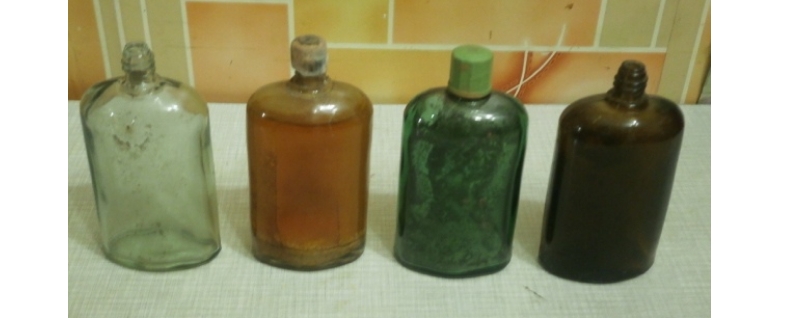
In 1942, in addition to the IPP-5, the IPP-6 was adopted . IPP-6 was a gauze bag with a dry powder-like degasser, embedded either in an outer bag made of tent fabric, or in a flat cardboard box. The weight of the package was 40 - 50 g. In terms of its properties, the IPP-6 degasser was similar to the IPP-5 degasser, some of the difference between the first and the second is its weaker irritant effect on the skin and a slightly slower reaction with OM. Due to the latter circumstance, it was necessary to process uniforms on humans very vigorously, achieving enhanced rubbing of the distribution of OM over a large area (= better contact with the powder of the degasser). The rules for using the IPP-6 differed for summer / winter conditions, so I will even quote the instructions:
In the summer : Open the package. Take out the bag. While wetting it with water, vigorously wipe the infected skin and clothing with it (soak clothing to the body). When wiping your face, take care of your eyes.
In winter : Mix the powder with the snow (half a bag for a handful of snow). Wipe the infected areas of the overcoat and skin until the snow melts. So repeat it twice. If possible, wash or clean the degassed clothing with snow, wash the skin with water.

In the postwar years, nerve agents from the class of organophosphorus compounds became the main type of chemical weapons. In this regard, an individual anti-chemical package IPP-51 , equipped with a two-liquid degassing formula , was developed and adopted in 1954 for supplying the Soviet army .

This bag was housed in a plastic box, sealed with PVC tape, which contained two vessels (small and large) in gauze bags, four small ampoules with a smoke control mixture, and four gauze napkins. A 15% solution of sodium cresolate in 95% ethyl alcohol contained in a small vessel was intended to neutralize the Sarin-type OM in the composition of IPP-51, and 82% ethyl alcohol contained in a large vessel with powdered monochloramine B and zinc chloride was used to degass the OM-type mustard gas. Later in the USSR, a single-liquid polydegassing alcoholate formulation was developed, which became part of IPP-8, and subsequently IPP-9.
Since up to IPP-8, an anti-smoke mixture was used in individual packages, this miracle of the domestic Military Industry should be said separately. German soldiers had Pervitin , while Soviet soldiers had to be content with solvent. I will quote myself in the article Memo for the victim of tear gas / pepper bottle
RU Wikipedia (2005 , ) CS ( ) — .. . , — , , - . , … , .
UPD. vvz732 c : 0,894 , 0,621 , 0,598 , 0,04 .
, . , - — " … , , , , " NIOSH . . — . , — . . , -, . .
The individual anti-chemical package IPP-8 (for civilians - IPP-8 A ) was adopted for supplying the Soviet Army and the Navy in 1966. It was a glass bottle containing 135 ml of polydegassing formulation, complete with four cotton gauze swabs and a memo according to the application of the bag, packed in a hermetically sealed polyethylene bag. The degassing liquid is a mixture of sodium hydroxide, ethyl cellosolve , dimethylamine , dimethylformamide . In various variations, methyl cellosolve could be used instead of ethyl cellosolve, additives of isopropyl alcohol, sulfonol, diethylenetriamine, etc.

Industrial production of IPP-8 was discontinued in 1987, however, due to the high stability of the formulation, the shelf life of this package was extended for a period of at least 20 years. The IPP-8 formulation owed its popularity to its excellent ability to degass most of the chemical warfare agents by dissolving, washing off, and alkaline hydrolysis. The recipe was distinguished by a high speed and efficiency of degassing, with the defeat of organic phosphorus toxic substances (FOB) and mustard gas, the degassing efficiency was twice as high as compared to the degassing package M-258A1 (about it in the foreign IPP section).
Individual anti-chemical package IPP-9was a metal container with a lid. Under the cover were cotton-gauze swabs and a punch with a spongy swab (fungus).
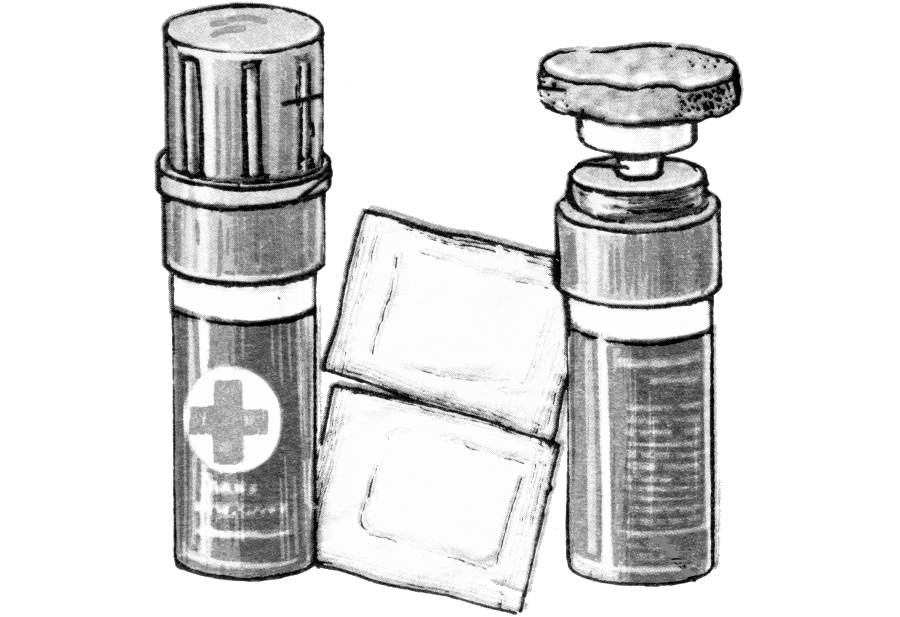
The composition of IPP-9 was similar to that of IPP-8: the same mixture of sodium hydroxide, ethyl cellosolve, dimethylamine, and dimethylformamide. Due to the fact that the solvent-based formulation had a strong irritant effect when it gets on mucous membranes and a pronounced degreasing effect (due to the destruction of the lipid barrier of the skin - about it, see the article Hard water and scale. Structure, properties and ways to minimize damage ) and as a consequence, the simplification of the penetration of OM through the treated areas of the skin when they re-enter - it was replaced by a more gentle version, which in 1987 went into a series called IPP-10. As a retrospective - pieces from the posters, from left to right IPP-8 (a) ... 9 (b) ... 10 (c).

The basis IPP-10 was based on the formulation of lanthanum nitrate, so-called " Langlik " (liniment of complex salts of rare earth elements in polyoxyglycols). The composition for protecting and degassing the skin contains the following components, in wt%:
- Lanthanum nitrate hexahydrate, calculated as lanthanum - 2.2 - 2.8
- Triethylene glycol - 60 - 64
- Ethylcarbitol = Diethylene glycol monoethyl ether - 24 - 27
- Glycerin - 1.8 - 2.2
- Caustic soda - 0.7 - 0.9
- Water is the rest
Or a simplified version:
- - Hexahydrate of lanthate nitrate in terms of lanthanum - 2.2 - 2.8
- - Ethylcarbitol = Diethylene glycol monoethyl ether - 24 - 27
- - Caustic soda - 0.6 - 0.8
- - Water - Not more than 3.0
- - Triethylene glycol - the rest
This bag was a 240 g metal can with a punch cap containing 160 ml of degassing formulation.

The main disadvantages of the IPP-10 was the metal cylinder itself. The individual anti-chemical package of the film-tampon type IPP-11 , which included the same formulation based on lanthanum nitrate, was deprived of these shortcomings, adopted for the supply of the RF Armed Forces in 2001 . This bag is enclosed in a 9x13 cm flat sealed laminated foil package containing four swabs soaked in degassing solution.
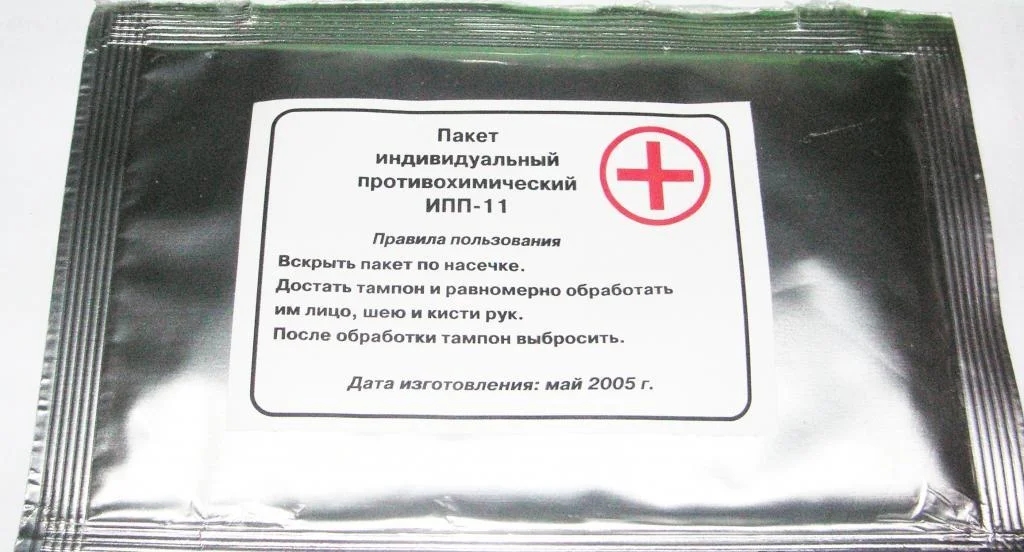
The difference between IPP-11 and all other degassers is that it can be used for prophylactic purposes (if there is a threat of organophosphorus poisoning): open skin is treated 20-30 minutes before possible contact with the toxin. In the case of pretreatment of the skin, the time of effective degassing with repeated application of IPP-11 can increase up to 20 minutes, however, the greatest efficiency is achieved in the first minutes after the ingress of toxicants on the open areas of the skin. This is probably why the composition of the IPP-10 ... 11 is still in service, unchanged since 1987.
I will go over approximately according to my vision of the role of each of the components of the composition.
- La3+. , , . , , , . … , . , , (La, , Pr, Nd) , .. . .
- — , - . , .
- — . , -> -11
- . , . pH 6,8-7,4
- Glycerin acts as an additional stabilizer and softener. Although when the content of the component in the formulation is exceeded, the viscosity will begin to increase and the degassing activity will decrease due to the formation of salts - lanthanum glycerates, whose activity is much lower than that of triethylene glycerates (p. 2)
In the complete set with IPP-11, you can also recall the individual degassing package IDP, which, surprisingly, is still quite alive and is found in some parts (in Belarus it is exactly).

It is intended for degassing and disinfecting personal weapons. It is a tin case containing two sealed glass ampoules. One of them (with red markings) contains 60 ml of degassing solution No. 1 (5% solution of hexachloromelamine (DT-6) or 10% solution of dichloramine (DT-2) in dichloroethane), the other (black markings) contains 60 ml degassing solution No. 2 - asch (ammonia-alkaline = aqueous solution of 2% sodium hydroxide, 5% monoethanolamine and 20% ammonia.). Sometimes instead of degassing solution No. 2-asch can be used solution No. 2- bsh ( ammonia-free alkaline = aqueous solution of 10% sodium hydroxide, 25% monoethanolamine). The lid of the case holds five cleaning paper wipes.
In addition to individual degassing with liquid compounds, the Soviet (and now Russian) Voenprom also took care of the degassing of personal weapons. Moreover, everything is a little more interesting here, because powder degassers are involved (~ close to the topic of enterosorbents, which I am actively promoting now - see Enterosorbents. Intro and Enterosorbents. Activated carbon ).
So, degassing, decontamination and disinfection of personal weapons, personal protective equipment and uniforms in domestic realities are carried out using degassing packages of silica gel DPS-1 or modernized powder packages (DPP-M).
The first of them, a degassing silica gel package DPS-1intended for partial special treatment of contaminated personal protective equipment, uniforms and bandages. It contains a mixture of silica gel (80%), aluminosilicate (5%), and alkali metal phenolate (15%). All this is in the form of a powder, packed in a waterproof film shell.
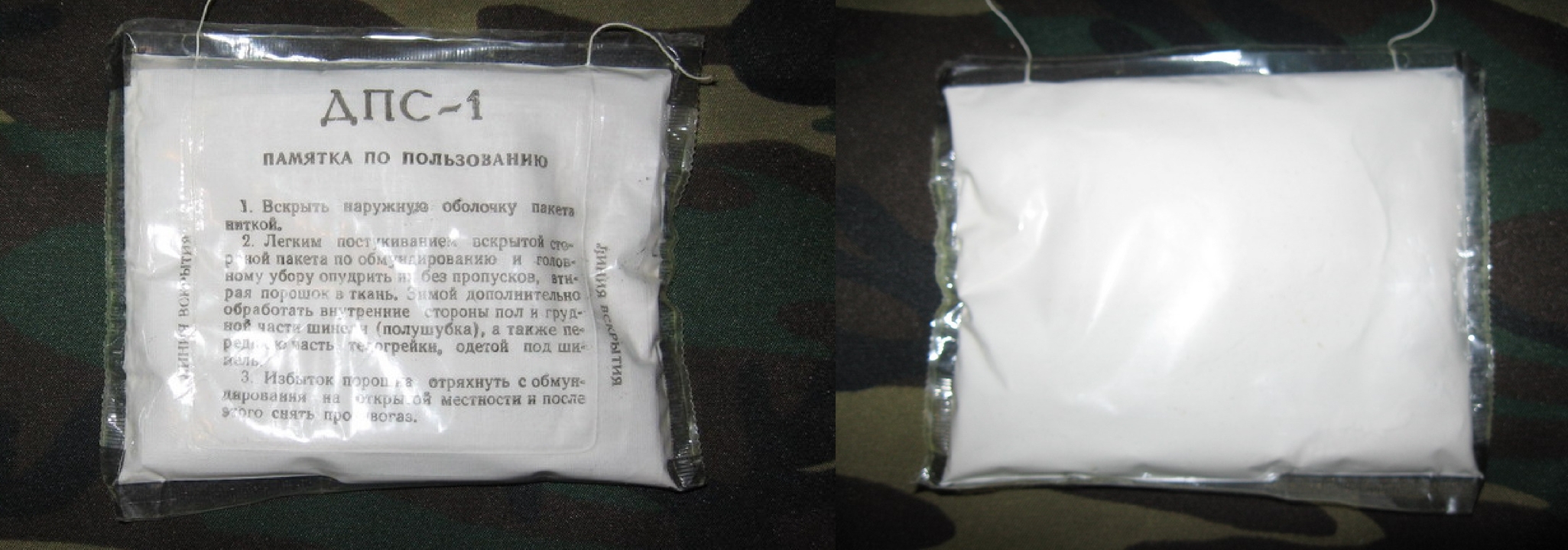
When processing uniforms and dressings with the formulation of the DPS-1 package, not only degassing (due to phenolate) occurs, but also active sorption of toxic substances on the powder, which significantly reduces the risk of secondary inhalation lesions. Therefore, this powder degasser can be successfully used to eliminate the secondary desorption of toxic substances from personal protective equipment, uniforms and dressings.
In 1991, a modernized degassing powder package DPP-M was adopted for supplying the army, which, along with degassing properties, ensured the impregnation of uniforms and imparting temporary protective properties to them in terms of OM.

The composition of both DPP and DPP-M, and DPP-M1 includes a degassing powder, which in general contains (wt.) 30% of the active oxidant and 70% of the sorbent. Trichloroisocyanuric acid is used as an oxidizing agent, an alkaline earth metal oxide (most often magnesium) is used as a chemisorbent, and aluminosilicates are the physical sorbent. In addition, a substance that increases adhesion, chlorinated paraffins, can be introduced. The approximate composition is shown in the table, in wt%:

In addition to DPP, powder formulations "ASK", "P-9", "PS-1HP" are currently used in Russia. "ASK" is a sorbent of toxic chemicals and contains (wt.) Aluminum oxide 14% and silica gel 86%. In "P-9" is used (wt.) 50% of the active oxidizing agent, 50% of the sorbent, of which silica gel is 5%. "PS-1KhP" consists of (wt.) 46% of an active oxidant, 54% of an aluminosilicate sorbent. Abroad, there were also references to such mixtures based on inorganic compounds. An example can be a degassing powder composition based on bleach, magnesium oxide and hydrophobic silicic acid (wt%): bleach - 65% (active oxidizer), magnesium oxide - 33% (chemisorbent) and silicic acid 2% (patent DE 3625583), an adsorption-type degassing powder containing a mixture of bentonite,activated carbon and calcium oxide (DE 300771), or an American complex degasser based on activated alumina, magnesium monoperoxyphthalate, Ag-zeolites and Na-zeolites (US patent 6537382).
IPP of NATO countries
Despite the abundance of variations of domestic APIs, one should not assume that less attention was paid to this abroad. Everything was just done "rarely, but accurately". The first of the individual anti-chemical packages accepted for supply in 1958 was the two-component degassing package M258 .
This API is a plastic case that contains 4 film envelopes. Inside envelope N1 there is a non-woven swab soaked in a solution of the following composition:
- Ethyl alcohol - 72 ± 2%
- Phenol - 10 ± 0.5%
- Caustic soda - 5 ± 0.5%
- Ammonia - 0.2 ± 0.05%
- Water is the rest
The other two envelopes (N 2) contain a swab made of nonwoven material impregnated with chloramine B and 3 sealed glass ampoules placed in a filter bag and containing an aqueous alcohol solution of zinc chloride (ethyl alcohol - 45 ± 2%; zinc chloride 5 ± 0.5 %; water - the rest). Degassing envelope N1 is effective for neutralizing organophosphates (sarin, soman); degassing envelope N2, which contains chloramine, is used to neutralize type VX OM and mustard gas.
At the end of the XX century. this package was replaced by an individual anti-chemical package 2581 , which is a plastic case containing two sets of napkins soaked in degassing solutions No. 1 and No. 2 and wrapped in foil-clad plastic.
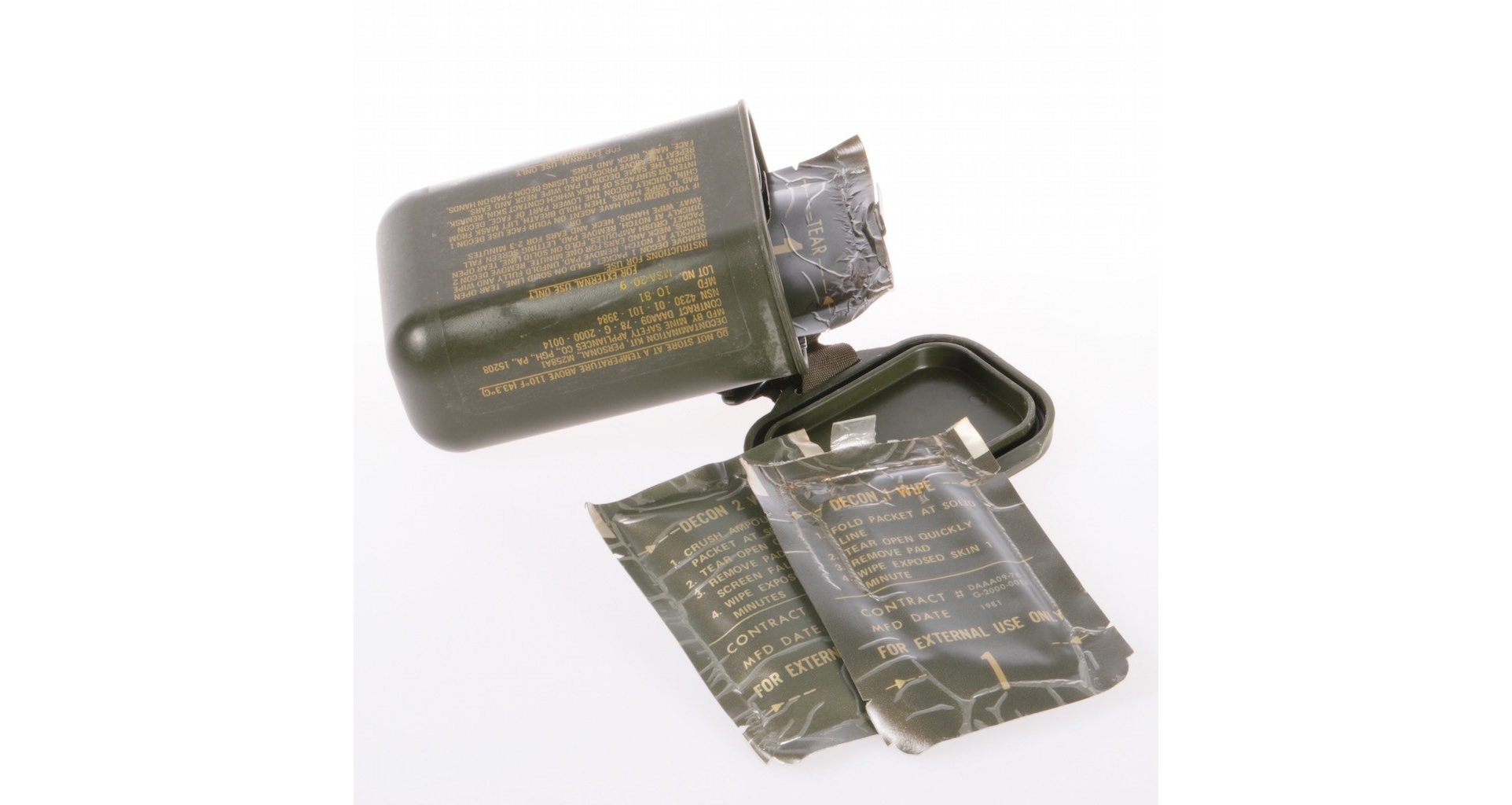
Currently, NATO uses individual degassing packages RSDL (Canada), 291 and 295 (USA), as well as MK1 (Great Britain).
The individual degassing package RSDL (Reactive Skin Decontamination Lotion Kit) is a 1.25M solution of the potassium salt of 2,3-butanedione monoximate in polyethylene glycol monoethyl ether with an average molecular weight of 550 daltons ( mPEG550 ) and 10% (wt.) Water (pH 10, 6):

For impregnation, a pad made of Opcell special polystyrene material is used. It is used instead of a cotton pad, due to the fact that it absorbs much more solution than any usual fibrous materials. The liquid phase is an important component of the formulation, since sorption, retention, and subsequent degassing of organic matter takes place in it according to the oxidation principle. The RSDL package recipe is effective against chemical warfare agents of nerve-paralytic and skin-blistering action in the modes of “protection”, “degassing”, as well as in combined use. Important! RSDL FDA approved to remove mycotoxin T-2 from skin.
The American company "Rohm and Haas Company" developed the M-291 kit , which was accepted for supply to the US Army in 1994.

It is intended for degassing open areas and has now completely replaced the M-258A1 kit that was previously on supply (
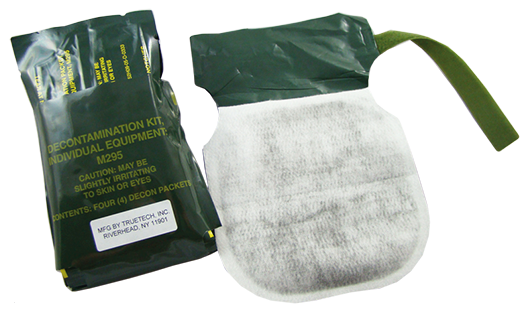
The M-291 and M-295 kits contain the same formulation based on Ambergard XE-555 resin (a mixture of halogenated styrene / divinylbenzene resins). M291 consists of three main components - a fiber pad (6 pcs.), The same activated carbon and Ambergard XE-555 ion exchange resin. Activated carbon, in addition to its direct, sorption purpose, also serves as an indicator. The presence of black staining tells the soldier that the toxic substances, albeit sorbed, are still on him and it is advisable to remove / shake / wash them off without delay.

And finally, the English individual degassing package MK1 includes 94 g of fuller's earth or floridin - dried crushed white clay. The package recipe is effective against chemical warfare agents of nerve-paralytic and skin-blistering action only in the "degassing" mode.
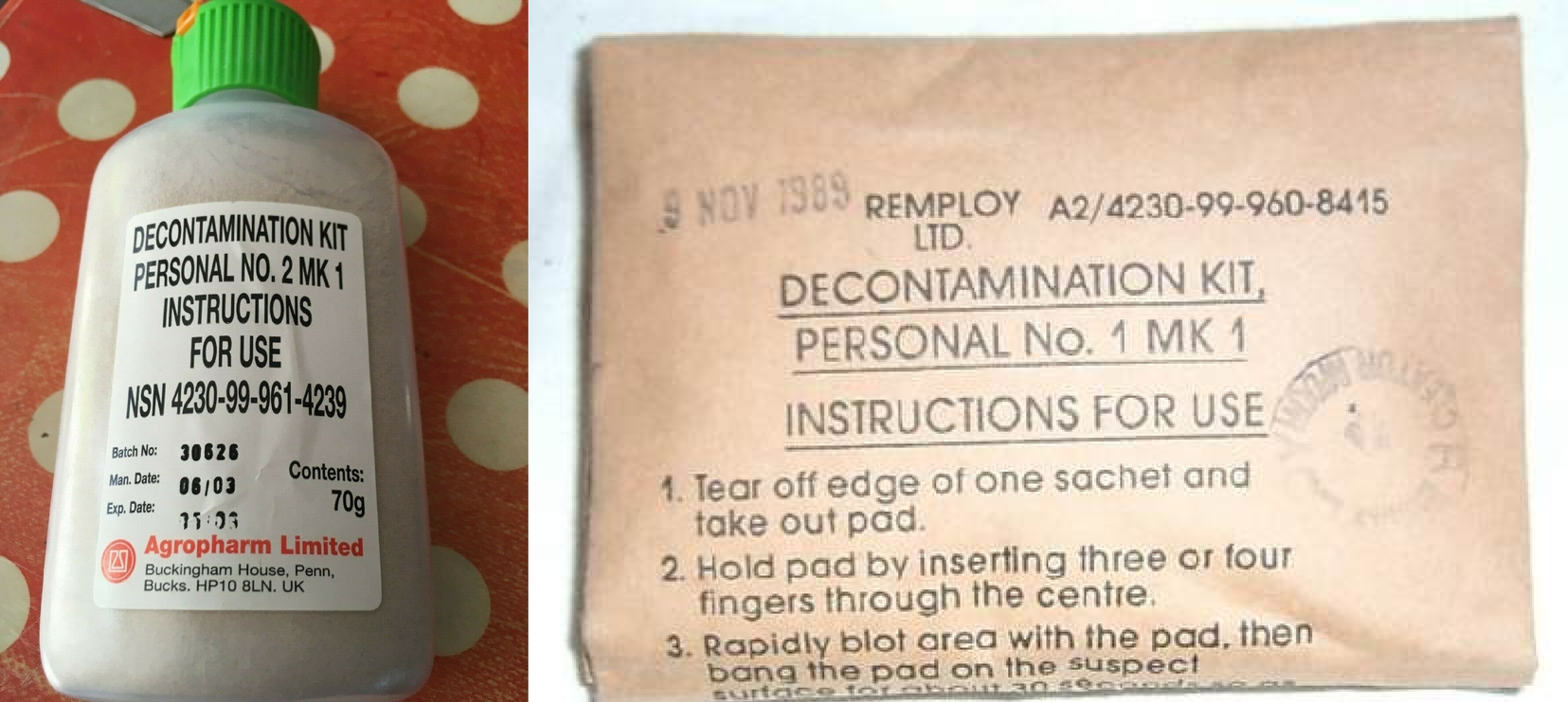
Fuller's earth (other names - attapulgite, floridin, bleaching clay) is a clay mineral of the montmorillonite group . Attapulgite differs from ordinary clay by a large percentage of water and a lack of plasticity. About clays and clay adsorbents - in the forthcoming article Enterosorbents. Silicon-containing sorbents
It is important to note that RSDL, M291, M295 and MK1 are powder formulations, capable of degassing OVTV only by the principle of physical removal and chemisorption, do not have a protective effect and cannot be applied in advance to protect the skin.
Peacetime API
Today, fortunately, it is quite unlikely that suddenly in any of our cities there will be either mustard gas, or sarin, or VX. Although the threat of poisoning with organophosphate compounds still exists, there are industrial pesticides, insecticides, etc. But in general, the main irritating agent is capsaicin or hot pepper extract. Almost a third of the article A Memo for a Tear Gas / Pepper Bottle Victim is devoted to his Pungency . But in the article everything revolved around the desire to wash off, wash off, wash off the extract that got on the skin. After reading this article, I hope someone will get the idea that " you don't need to wash off, adsorb ."
So, consider the process of getting an aerosol on your face. Fat-soluble capsaicin is mixed with a propellant gas (such as propane) in a gas cartridge and is sprayed in a controlled manner into the face of the offender. The spread of capsaicin gas aerosol is similar to the spread of the coronavirus bioaerosol when sneezing. When the emulsion falls on the face of a person, drops of emulsion settle on it, the dissolved capsaicin begins to interact with the ion channels of the human body (type TRPV1 channels ) and causes a burning / lacrimation effect, etc., etc.
Two situations can be considered: a) how to prevent capsaicin from getting on the face / mucous membranes and b) how to remove capsaicin from the face. In the first case, everything is quite simple and has long been described using the example of the same bioaerosols. See the article Stop COVID-19. Everything about air filtration in case of a pandemic and Coronavirus 2019-nCoV. Respiratory protection and disinfection FAQ . There the question of PPE / RPE is described in sufficient detail.
But what to do when there were no remedies on the face and the emulsion got into the mucous membranes of the skin? The most common advice is to wash off the emulsion from the skin. And most often it is advised to wash off with milk. I hope now it is clear why an African American is on KDPV :) He is treated, by the way, with "magnesian milk", more about him later.
I thought for a long time what chemical analogy to choose for capsaicin. Let's say engine oil gets on the skin (the so-called “working off”, ie oil with soot particles from burnt fuel and metal particles formed from friction of metal parts of the engine against each other). What will you do in this situation? Hardly anyone will offer to wash off butter with milk. Most likely the advice would be "wipe with an oil-absorbing rag." In principle, this advice is also relevant in the case of a tear spray. It is necessary to bind the drops of oily liquid and not allow them to spread further. There is always a layer of fat on our skin. And thanks to this, the fat on the skin is mixed with the skin fat, so to speak, "interpenetrates" and makes the transport of capsaicin molecules (due to Brownian motion) more efficient. Those. I would venture to suggestthat people with dry skin (as opposed to people with oily skin) are less afraid of capsaicin aerosols. If suddenly someone somewhere has seen such a study in the open press, I will gladly accept the link as a gift and attach it to the article.
It can be assumed that if you remove the fat layer from the skin, or even better make the skin " oleophobic " or lipophobic (that is, repulsive or NOT adsorbing fats, like screens of modern smartphones that prevent fingerprints), then capsaicin from aerosol drops will be very slow penetrate the skin, if at all. Technically, emulsion drops should collect in large drops and drain directly from the face. To create oleophobic coatings, alkylsilanes (silicones with various functional groups) or other fluorine-containing compounds (such as fluoroplastics) are used.
I do not know if there are any means to make the skin lipophobic (without damaging the skin itself) - therefore I will not touch on this issue for now.
The second option is to tie the extra fat on the skin. This procedure is already practiced in the world and is in demand among various athletes - from gymnasts to climbers. Constantly released cutaneous fat makes the hands slide, which is "like death" for many sports both figuratively and literally (see "rock climbing" or weightlifting). In order to make your hands dry and sensitive, a substance such as sports magnesia is used , it is also the basic magnesium carbonate 4MgCO3 * Mg (OH) 2 * 4H2O (similar to the medicine " white magnesia " mMgCO3 * Mg (OH) 2 * nH2O, which is used as an antacid and antiulcer drug). There is even a known method ( RU Wikipedia) to remove greasy stains from fur / fabric / wool:
, , , . , , . , .
And here we once again see all the "brilliance and poverty" of Russian Wikipedia, which I have already mentioned a million times. An article about magnesium salt, and stains are removed by "burnt magnesia", i.e. magnesium oxide MgO. So the thesis "looking for chemical information - forget about Russian Wikipedia!" working. The resource requires years of fact-checking. But, as applied to tear gas, magnesium oxide can still be tried.
Note : the answer to the question “where can I find this burnt magnesia, in my taiga village? If a gas cylinder with capsaicin was found in the taiga, it is likely that it will be possible to find fertilizer "magnesium sulfate" and ammonia 10%.
In principle, instead of burnt magnesia, you can use some other adsorbents with high oil absorption. Oil absorption - term from the paint industry:
Oil absorption is a quantitative value that characterizes the wetting of pigments by a film-forming substance, which is usually taken as bleached linseed oil. Oil absorption of the first kind - the amount of linseed oil required to obtain a plastic mass from 100 g of dry pigment in the form of a lump of adhered particles
Those. Based on this characteristic, any pigment with sufficiently small particles can be used as a “tear gas adsorbent”. True, here it is also important not to overdo it and when applying the powder to the skin, close your eyes and nose (= "do not inhale") so that there are no problems, as with magnesia.
, , «» . , - , , , , , , , . , - . , . , , - , , , .
By the way, no one bothers to use the previously mentioned Fuller's earth, which is the English IPP MK1, as an adsorbent of capsaicin. It is not difficult to find this type of clay - it is actively used as cosmetic masks and is sold ... Yes, even on the same iHerb

It would be strange if the Western "community of private inventors and innovators" did not offer anything in case of tear gas. It also suggested. The leader is Fox Labs , a major manufacturer of lacrimators and civilian self-defense / special purpose equipment. I like their logo, sorry, reader, for the non-thematic picture:

So, in the list of products manufactured by this company, there are special decontamination wipes that are equally good (according to the company's assurances), coping with all types of tear aerosols. They are called Sudecon Decontamination Wipes :

If SDS is not lying to us, then these wipes are impregnated with a composition consisting of 1% Germaben II component and 4.2% surfactant mixture called Mackadet BSC-ND. Germaben II is a product used to inhibit the growth of microbes, yeasts and molds in cosmetics. It contains propylene glycol, propylparaben, methylparaben and diazolidinylurea. And Mackadet BSC-ND is a proprietary blend of Sodium Laureth Sulfate, Cocamide DEA, Disodium Oleamido MEA Sulfosuccinate, Disodium Cocoamphodiacetate and Cocamidopropyl Betaine. The surfactant blend is actually excellent and probably not cheap. How many times I tried to find some shampoo with the mentioned components in the cosmetics department of the Minsk Central Department Store - all to no avail. But (attention!) Hippallergenic dog shampoo “8in1” was very close to the desired composition. The photo is approximate, as according to the seller “the company has a rebranding and the shape of the container has changed”. Estimated price - about $ 15. For those who are intimidated by the price, I would venture to suggest that regular soap makeup remover wipes should work similarly.

In addition to napkins, there are also special sprays that need to be applied to areas of the skin affected by lacrimators (mind you, not your eyes!). These are SABER Decon and BioShield. Unfortunately, nothing was found in the composition, except that some natural (even herbal?) Components are used there that relieve pain from lacrimator and blah-blah-blah. I suspect inside is the same familiar combination of some surfactants + some lidocaine. In general, there is no technical creativity.
The outlook for the future
It's time to summarize. I would like to say that the topic of chemical degassers is actively developing in the West (this is not IPP-11, which has not changed since 1987, although it may be, indeed, incredibly good). The use of ion-exchange resins and sorbents based on fullerenes, as well as the use of perfluorocarbons as polydegassing formulations, are considered as the most promising areas of research. In the United States, there was even (perhaps there is) the Topical Skin Protectants (TSPs) program, within the framework of which there is an active development of degassing compositions based on fluorinated compounds. Interestingly, scientific thought is shifting away from active oxidation, towards creating a protective film on the skin. Those. "Preventing is easier than curing." Organic compounds are able to be well distributed over the surface of the skin, create a thin elastic film that does not impede movement and can be easily removed with a cotton-gauze swab. At the same time, due to active micelle formation, such films are able for a sufficiently long time to prevent the transfer of molecules of individual chemical warfare agents, concentrated alkalis and other aggressive technical fluids into the depth of the skin. A very promising direction is the use of nanodispersed metal oxides as degassing powders.These compounds, due to a change in their degree of dispersion, significantly increase their activity and, even at room temperature, are capable of causing catalytic oxidation of various OM with the formation of low molecular weight inorganic molecules. As an adherent of colloidal chemistry and an adsorption specialist, I believe that the issue of using natural aluminosilicates has not been disclosed at all and there are many interesting solutions, which means that the topic is waiting for its researchers ...then the topic is waiting for its researchers ...then the topic is waiting for its researchers ...
For all questions - go to the tg-channel LAB-66 or Patreon .

You can thank the author for the information in traditional ways:
YooMoney 410018843026512 ,5536 0800 1174 5555
bitcoin crypt: 3QRyF2UwcKECVtk1Ep8scndmCBoRATvZkx
crypt ether: 0x3Aa313FA17444db70536A0aBA5493F3
REFERENCES
. I . . — : , 2008.
.., .., .. , , / .. . . — .: , 1983.
.., .., .. , , . 2. .- .: , 2003.
.. . 1 , / . . .. .. . . — .: , 1988
.. , . ( ) . -: , 2007.
. — .: , 1988.
. — .: , 1989.
(). — .: , 2002.
Bismuth, C., Borron, S.W., Baud, F.J., Barrioit, P. (2004).Chemical weapons: documented use and compounds on the horizon. Toxicol. Lett. 149: 11–18.
Brodsky, B., Wormser, U. (2007). Protection from toxicants. Curr.Probl. Dermatol. 34: 76–86.
Ember, L. (1997). Detoxifying nerve agents. Chem. Eng. News September 15, 26–9.
Gordon, R.K. Owens, R.R., Askins, L.Y., Baker, K., Ratcliffe, R.H., Doctor, B.P., Clarkson, E.D., Schulz, S., Railer, R., Sigler, M., Thomas, E., Ault, K., Mitcheltree, L.W. (2006). Formulation of polyurethane sponges for chemical, biological, and radiological decontamination and detoxification. Proceedings of the 2006 Medical Defense Bioscience Review. Therapeutics: 43–44.
Houston, M., Hendrickson, R.G. (2005). Decontamination. Crit. Care Clin. 21: 653–72.
Hurst, C.G. (1977). Decontamination. In Chemical Warfare Agents Textbook of Military Medicine (R. Zaitchuk, ed.), pp. 351–60. Office of Surgeon General, Falls Church.
Martin, T., Lobert, S. (2003). Chemical warfare. Toxicity of nerve agents. Crit. Care Nurse 23: 15–20.
Decontamination of organophosphorus compounds: towards new alternatives / Poirier L., Jacquet P., Elias M., Daud D., Chabri re E. // Annales Pharmaceutiques Fran aises. 2017. Vol. 75, Issue 3. P. 209–226.
.., .., .. , , / .. . . — .: , 1983.
.., .., .. , , . 2. .- .: , 2003.
.. . 1 , / . . .. .. . . — .: , 1988
.. , . ( ) . -: , 2007.
. — .: , 1988.
. — .: , 1989.
(). — .: , 2002.
Bismuth, C., Borron, S.W., Baud, F.J., Barrioit, P. (2004).Chemical weapons: documented use and compounds on the horizon. Toxicol. Lett. 149: 11–18.
Brodsky, B., Wormser, U. (2007). Protection from toxicants. Curr.Probl. Dermatol. 34: 76–86.
Ember, L. (1997). Detoxifying nerve agents. Chem. Eng. News September 15, 26–9.
Gordon, R.K. Owens, R.R., Askins, L.Y., Baker, K., Ratcliffe, R.H., Doctor, B.P., Clarkson, E.D., Schulz, S., Railer, R., Sigler, M., Thomas, E., Ault, K., Mitcheltree, L.W. (2006). Formulation of polyurethane sponges for chemical, biological, and radiological decontamination and detoxification. Proceedings of the 2006 Medical Defense Bioscience Review. Therapeutics: 43–44.
Houston, M., Hendrickson, R.G. (2005). Decontamination. Crit. Care Clin. 21: 653–72.
Hurst, C.G. (1977). Decontamination. In Chemical Warfare Agents Textbook of Military Medicine (R. Zaitchuk, ed.), pp. 351–60. Office of Surgeon General, Falls Church.
Martin, T., Lobert, S. (2003). Chemical warfare. Toxicity of nerve agents. Crit. Care Nurse 23: 15–20.
Decontamination of organophosphorus compounds: towards new alternatives / Poirier L., Jacquet P., Elias M., Daud D., Chabri re E. // Annales Pharmaceutiques Fran aises. 2017. Vol. 75, Issue 3. P. 209–226.